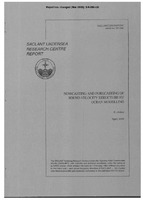| dc.contributor.author | Onken, Reiner | |
| dc.date.accessioned | 2018-10-11T14:08:55Z | |
| dc.date.available | 2018-10-11T14:08:55Z | |
| dc.date.issued | 1999/04 | |
| dc.identifier | 12224 | |
| dc.identifier.govdoc | SR-292 | |
| dc.identifier.uri | http://hdl.handle.net/20.500.12489/534 | |
| dc.description.abstract | The Harvard Ocean Prediction System (HOPS) is applied to an observed oceanographic data set in | |
| dc.description.abstract | order to demonstrate that a dynamical ocean model is able to provide meaningful extensions in space (nowcast) and time (forecast) of the sound velocity field. The model is set up with a high number of | |
| dc.description.abstract | vertical layers in order to resolve sufficiently the details of sound velocity profiles. The high resolution observational data collected in February 1997 in the Antalya Basin (Eastern Mediterranean Sea) is serving for initialization of the model and for validation of the model results. For assessing the | |
| dc.description.abstract | nowcast capability, HOPS is initialized by a subset of observational data at half the horizontal resolution of the original sampling scheme. The sound velocity field is obtained by objective analysis. Observations are weighted by a correlation function that uses the Rossby radius as a natural scale of influence for dynamical processes in the ocean. The modelled sound velocity distribution is validated by comparison with the full resolution observed distribution at the respective locations, and it is shown that the objectively analyzed sound velocity matches the observations better than the sound velocity distribution obtained by a classical interpolation scheme with inverse distance weighting. For the | |
| dc.description.abstract | forecast experiment, the observational data set is separated in two subsets which occupy the same | |
| dc.description.abstract | positions but are different in time. HOPS is initialized with the earlier data set and integrated in time | |
| dc.description.abstract | until the end of the survey. By comparing the forecasted and observed sound velocity during the | |
| dc.description.abstract | course of the integration, it is verified that the predicted profiles, their vertical gradients, and the depth of the main sound channel axis provide a better match with the validation data than making the assumption that no change has occurred during the forecast period. | |
| dc.format | 60 p. : ill. ; 22 fig. | |
| dc.language | English | |
| dc.publisher | NATO. SACLANTCEN | |
| dc.relation.ispartofseries | ADB249135L | |
| dc.subject | Sound velocity in sea water | |
| dc.subject | Oceanography - Mathematical models | |
| dc.subject | Antalya Basin | |
| dc.subject | Levantine sea | |
| dc.subject | HOPS (Harvard Ocean Prediction System) | |
| dc.title | Nowcasting and forecasting of sound velocity structure by ocean modelling | |
| dc.type | Scientific Report (SR) | |
